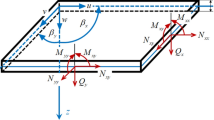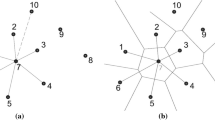Abstract
An efficient dual reciprocity hybrid radial boundary node method is developed for the analysis of Winkler and Pasternak foundation thin plate, in which a hybrid displacement variational principle, radial point interpolation method (RPIM) and dual reciprocity method (DRM) are combined. Firstly, the hybrid displacement variational principle is developed, in which the domain variables are interpolated by two groups of symmetric fundamental solutions, while the boundary variables are interpolated by RPIM instead of the traditional moving least square, and the shape function obtained by RPIM satisfies the delta function property, so boundary conditions can be applied directly. Besides, DRM is exploited to evaluate the particular solutions of inhomogeneous terms, which can be used to transform the domain integrals arising from the inhomogeneous term into equivalent boundary integrals. Finally, some additional equations based on the DRM theory are proposed to overcome the problem that the boundary integral equations are not enough to solve all variables. This method has the advantages of both no element mesh of meshless method and dimensionality reduction of boundary element method. Numerical examples of Winkler and Pasternak foundation plates are given to illustrate that the present method is effective, accurate and it can be further expanded into practical engineering.
Similar content being viewed by others
References
Mai-Duy M., Tanner R.I.: An effective high order interpolation scheme in BIEM for biharmonic boundary value problems. Eng. Anal. Bound. Elem. 29, 210–223 (2005)
Balas J., Sladek V., Skadek J.: The boundary integral equation method for plates resting on a two-parameter foundation. ZAMM 64, 137–146 (1984)
Wang J.G., Wang X.X., Huang M.G.: A boundary integral equation formulation for the Reissner’s plates resting on two-parameter foundations. Acta Mech. Solida Sin. 5, 85–98 (1992)
Nayroles B., Touzot G., Villon P.: Generalizing the finite element method: diffuse approximation and diffuse element. Comput. Mech. 10, 307–318 (1992)
Lu Y.Y., Belytschko T., Gu L.: A new implementation of the element free Galerkin method. Comput. Method Appl. Mech. Eng. 113, 397–414 (1994)
Atluri S.N., Zhu T.: A new meshless local Petrow-Galerkin approach in computational mechanics. Comput. Mech. 22, 117–127 (1998)
Han W., Meng X.: Error analysis of the reproducing kernel particle method. Comput. Methods Appl. Mech. Eng. 190, 6157–6181 (2001)
Atluri S.N., Sladek J., Sladek V., Zhu T.: The local boundary integral equation and it’s meshless implementation for linear elasticity. Comput. Mech. 25, 180–198 (2000)
Liew K.M., Yumin C., Kitipornchai S.: Boundary element-free method(BEFM) and its application to two-dimensional elasticity problems. Int. J. Numer. Methods Eng. 65, 1310–1332 (2006)
Mukherjee Y.X., Mukherjee S.: The boundary node method for potential problems. Int. J. Numer. Method Eng. 40, 797–815 (1997)
Kothnur V.S., Mukherjee S., Mukherjee Y.X.: Two-dimensional linear elasticity by the boundary node method. Int. J. Solids Struct. 36, 1129–1147 (1999)
Zhang J.M., Yao Z.H., Li H.: A Hybrid boundary node method. Int. J. Numer. Methods Eng. 53, 751–763 (2002)
Zhang J.M., Yao Z.H., Masataka T.: The meshless regular hybrid boundary node method for 2-D linear elasticity. Eng. Anal. Bound. Elem. 127, 259–268 (2003)
Wang H.T., Yao Z.H., Cen S.: A meshless singular hybrid boundary node method for 2-D elastostatics. J. Chin. Inst. Eng. 27, 481–490 (2004)
Miao Y., Wang Y.H., Yu F.: An improved hybrid boundary node method in two-dimensional solids. Acta Mech. Solida Sin. 18, 307–315 (2005)
Yan F., Wang Y.H., Tham L.G., Cheung Y.K.: Dual reciprocity hybrid boundary node method for 2-D elasticity with body force. Eng. Anal. Bound. Elem. 32, 713–725 (2008)
Yan F., Wang Y.H., Miao Y., Tham L.G., Cheung Y.K.: Dual reciprocity hybrid boundary node method for free vibration analysis. J. Sound Vib. 321, 1036–1057 (2009)
Li G., Aluru N.R.: Boundary cloud method: a combined scattered point boundary integral approach for boundary-only analysis. Comput. Method Appl. Mech. Eng. 191, 2337–2370 (2002)
Chen W., Tanaka M.A.: Meshless, integration-free, and boundary-only RBF technique. Comput. Math. Appl. 43, 379–391 (2002)
Fairweather G., Karageorghis A.: The method of fundamental solutions for elliptic boundary value problems. Adv. Comput. Math. 9, 69–95 (1998)
DeFigueredo T.G.B., Brebbia C.A.: A new hybrid displacement variational formulation of BEM for elastostatics. In: Brebbia, C.A., Conner, J.J. (eds.) Advances in Boundary Elements, vol 1, pp. 47–57. Computational Mechanics Publications, Southampton (1989)
Yan F., Feng X.T., Zhou H.: Dual reciprocity hybrid radial boundary node method for the analysis of Kirchhoff plates. Appl. Math. Model. 35, 5691–5706 (2011)
Leonetti L., Mazza M., Aristodemo M.: A symmetric boundary element model for the analysis of Kirchhoff plates. Eng. Anal. Bound. Elem. 33, 1–11 (2009)
Davi G., Milazzo A.: A meshfree method for transverse vibrations of anisotropic plates. Int. J. Solids Struct. 40, 5229–5249 (2003)
Zhang J.H., Ma L.H.: Nodes distributing scheme study of element-free method for foundation plate. J. Hebei Univ. (Nat. Sci. Ed.) 25, 20–23 (2005)
Katsikadelis J.T., Kallivokas L.F.: Plates on biparametric elastic foundation by BDIE method. J. Eng. Mech. ASCE. 114, 847–875 (1988)
Zhang W.X., Pang H.: Analysis of plates on the elastic foundation by the element-free method. Mech. Eng. 20, 38–41 (2000)
Author information
Authors and Affiliations
Corresponding author
Rights and permissions
About this article
Cite this article
Yan, F., Feng, XT. & Zhou, H. Dual reciprocity hybrid radial boundary node method for Winkler and Pasternak foundation thin plate. Arch Appl Mech 83, 225–239 (2013). https://doi.org/10.1007/s00419-012-0648-y
Received:
Accepted:
Published:
Issue Date:
DOI: https://doi.org/10.1007/s00419-012-0648-y




